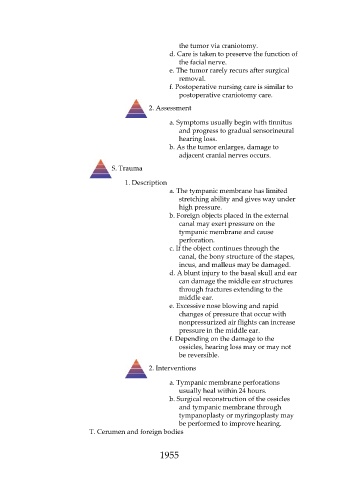Page 1955 - Saunders Comprehensive Review For NCLEX-RN
P. 1955
the tumor via craniotomy.
d. Care is taken to preserve the function of
the facial nerve.
e. The tumor rarely recurs after surgical
removal.
f. Postoperative nursing care is similar to
postoperative craniotomy care.
2. Assessment
a. Symptoms usually begin with tinnitus
and progress to gradual sensorineural
hearing loss.
b. As the tumor enlarges, damage to
adjacent cranial nerves occurs.
S. Trauma
1. Description
a. The tympanic membrane has limited
stretching ability and gives way under
high pressure.
b. Foreign objects placed in the external
canal may exert pressure on the
tympanic membrane and cause
perforation.
c. If the object continues through the
canal, the bony structure of the stapes,
incus, and malleus may be damaged.
d. A blunt injury to the basal skull and ear
can damage the middle ear structures
through fractures extending to the
middle ear.
e. Excessive nose blowing and rapid
changes of pressure that occur with
nonpressurized air flights can increase
pressure in the middle ear.
f. Depending on the damage to the
ossicles, hearing loss may or may not
be reversible.
2. Interventions
a. Tympanic membrane perforations
usually heal within 24 hours.
b. Surgical reconstruction of the ossicles
and tympanic membrane through
tympanoplasty or myringoplasty may
be performed to improve hearing.
T. Cerumen and foreign bodies
1955

